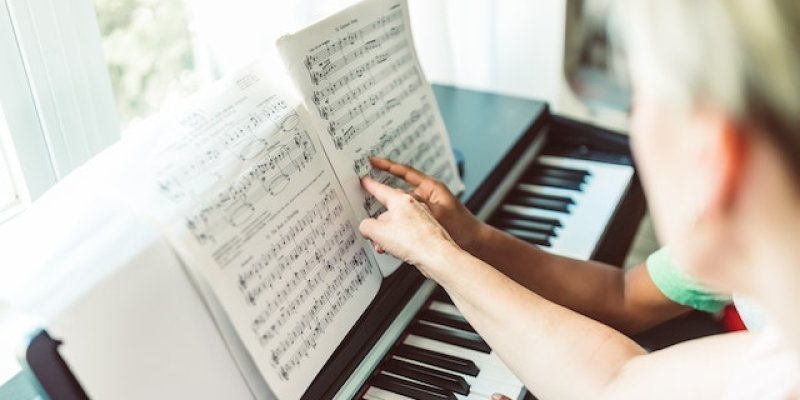
Music dynamics encompass the subtle or dramatic variations in volume and intensity that musicians infuse into their performances.
These fluctuations allow musicians to convey a wide range of emotions and moods, shaping the overall character of a musical piece.
Composers indicate dynamics through specific terms and symbols in the sheet music, guiding the performers on when to play loud, soft, or somewhere in between.
By skillfully implementing dynamics, musicians can add depth, contrast, and expressiveness to their interpretations, transforming a mere sequence of notes into a captivating artistic expression.
Understanding and utilizing music dynamics are fundamental for musicians across all genres, as they form a vital component of musical storytelling and audience engagement.
Related Post: 6 Essential Music Theory Basics Every Musician Should Know
Loud dynamic terms, also known as forte dynamic markings, instruct musicians to play with strength and intensity.
"Fortissimo" (ff) directs them to play at their loudest, while "forte" (f) indicates a strong and bold volume level. "Mezzo forte" (mf) suggests a moderately loud dynamic.
These markings empower musicians to deliver powerful and attention-grabbing passages that can evoke emotions such as excitement, triumph, or urgency.
When executed well, loud dynamic terms can create dramatic peaks in the music and drive the narrative forward, captivating the audience's attention and leaving a lasting impact.
Soft dynamic terms, represented by the Italian words for softness, guide musicians in producing gentle and delicate sounds.
"Piano" (p) indicates a soft volume level, while "mezzo piano" (mp) suggests a moderately soft dynamic. The softest level is "pianissimo" (pp), which requires musicians to play with utmost delicacy.
Soft dynamics offer moments of intimacy, introspection, and vulnerability in a musical piece.
These markings create opportunities for musicians to convey emotions like tenderness, tranquility, and sadness, drawing the audience into a more reflective and intimate experience.
Skillful execution of soft dynamics enables musicians to create beautiful contrasts, balancing the loud and soft passages to craft a nuanced and emotionally rich performance.
Related Post: How To Scream Sing (Without Wrecking Your Vocal Cords)
Dynamics are a key element in adding depth to a musical performance. By varying the volume and intensity, musicians can create layers of emotion and texture within the music.
For example, a gradual increase in volume can build anticipation and tension, leading to a powerful climax, while a subtle decrease can evoke a sense of introspection and contemplation.
These changes in dynamics give the music a three-dimensional quality, allowing it to resonate on a more profound level with the audience.
Additionally, dynamic contrasts can highlight different instrumental or vocal parts, bringing out the intricacies of the composition and enhancing its complexity.
Expressiveness in music is about communicating emotions and feelings through the performance.
Music dynamics play a pivotal role in achieving this expressiveness by enabling musicians to infuse their interpretations with sensitivity and passion.
Through soft dynamics, musicians can convey vulnerability, tenderness, and a sense of intimacy, while loud dynamics facilitate the expression of joy, excitement, and grandeur.
In this way, dynamics become the language of expression, making music an intensely moving and personal experience.
Related Post: How To Write A Song From The Heart That Is Deep And Meaningful
Dynamic contrast is the intentional variation and balance between loud and soft dynamics within a musical composition.
It involves skillfully transitioning between different volume levels to create expressive and engaging performances. The artful use of dynamic contrast can add excitement, tension, and emotional depth to the music.
A sudden shift from a soft passage to a powerful crescendo can generate anticipation and energy, while a gradual decrescendo from a fortissimo to a pianissimo can evoke a sense of resolution and calm.
By incorporating dynamic contrast, musicians can accentuate the narrative of the music, highlighting its emotional peaks and valleys, and holding the listener's attention throughout the performance.
Before diving into your performance or recording, outline a clear dynamic roadmap for your piece. Identify the sections where you want to emphasize specific dynamics, and mark them clearly on your music.
After your outline is set, you won't feel so overwhelmed with the idea of dynamics, yet you can still make adjustments accordingly as you practice.
Developing the ability to play or sing at various volume levels requires practice and precision. Spend time during rehearsals exploring different nuances of volume, ensuring each note is played at the intended dynamic level.
Actively practice this with your daily warmups. With a gentle, pianissimo sound, and gradually increase the volume to a powerful, fortissimo sound.
Then, return to a soft tone smoothly. This method improves your expression and ability to convey emotions through your instrument.
Just as a skilled speaker emphasizes certain words or phrases to convey feelings, musicians can apply similar techniques to their playing.
By studying the lyrics or underlying emotion of the music, musicians can experiment with dynamic variations that mirror the ebb and flow of spoken language, making the performance more relatable and evoking authentic emotions from the audience.
Remember that dynamics, like spoken emotions, should feel natural and purposeful, creating a compelling and emotive musical conversation between performers and listeners.
Related Post: Songs With Silence In Them - An Effective Songwriting Technique

As a session singer, writer, and producer that has worked with over 300 clients to provide high-quality jingles, singles, and features, Yona spends her time creating and marketing new music and helpful resources for creators. Check out Yona’s latest releases on her Spotify, her Youtube and share if you like it!
If you are in need of singer, songwriter or song producer services, see what Yona Marie can offer you on her services page.